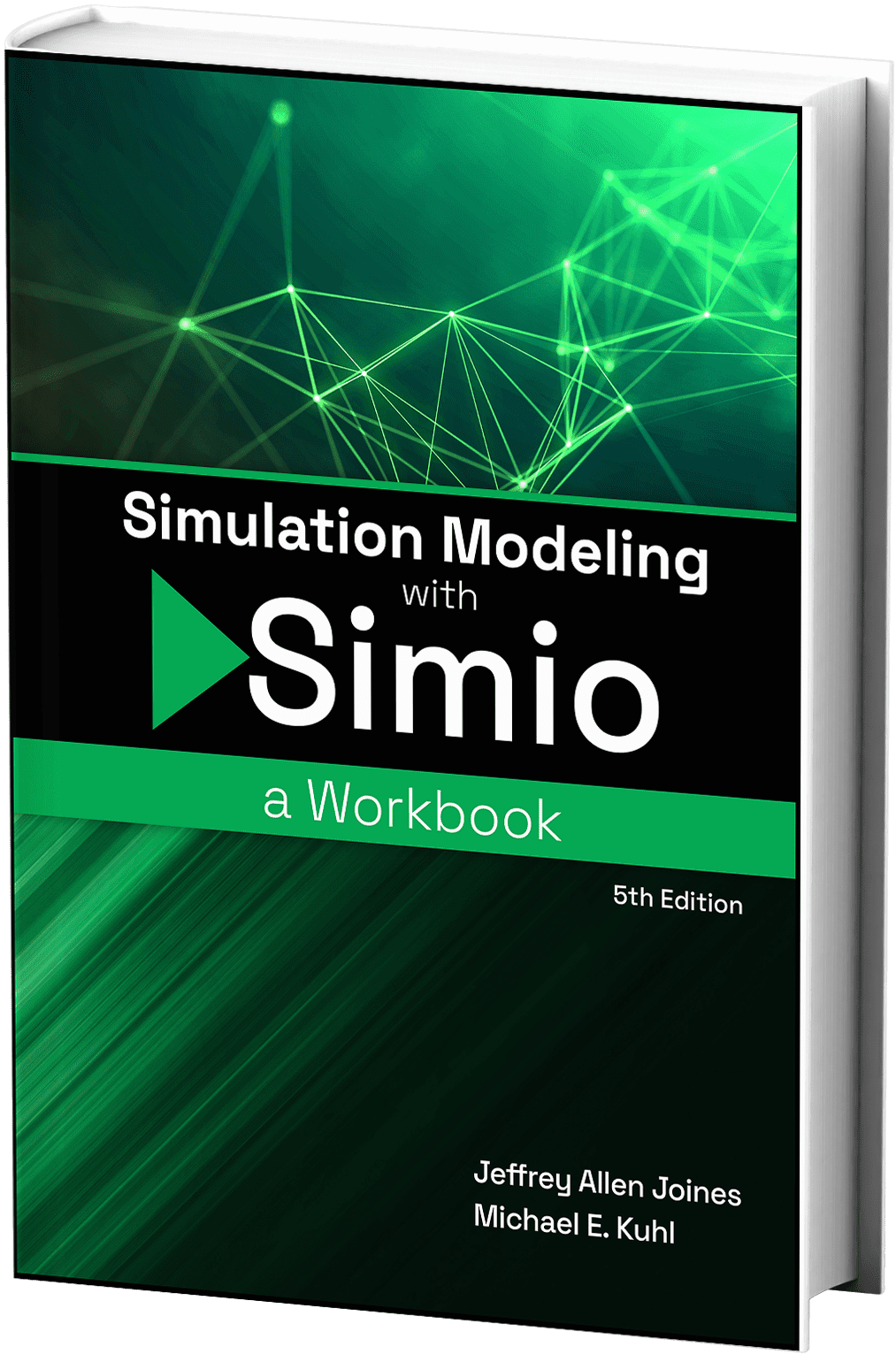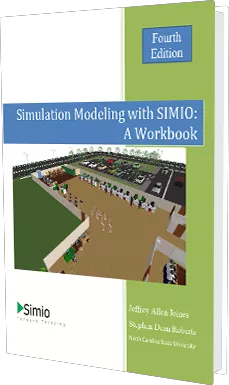
Simulation Modeling with SIMIO: A Workbook - 5th Edition
By Jeffrey A. Joines and Michael E. Kuhl
This edition of this workbook maintains the successful “participatory” style introduced in the first edition. You don’t sit and read the book without a computer loaded with SIMIO (the book was created using version 16.255 of SIMIO™). We expect your active participation in using SIMIO as you turn the pages. We try to carry on a conversation with you. Our belief is that simulation is not a spectator sport. You have to practice to gain skill with it and you develop that skill through modeling practice. This book encourages you to practice and use your skill, and feedback from earlier editions appear to validate the approach. This book retains its focus on simulation modeling with SIMIO and most of the simulation statistical analysis and analytical issues are more thoroughly covered in other books. We strongly suggest that if you are teaching/learning simulation that you also have one of these non-language books available.
Get it Now
Description
This edition of the workbook has been updated to version 16.255 of SIMIO. Also, a new co-author, Michael E. Kuhl, has taken over for Stephen Roberts, who retired after 40 years of being an educator. Also, thanks to SIMIO for making this version available for free. As in previous versions, emphasis is placed on “why” modeling choices are made to supplement the “how” of using SIMIO in simulation. Chapter 1 presents fundamental simulation concepts (e.g., events, event calendar, types of statistics, etc.) independent of SIMIO, which can be skipped for those who already understand these fundamentals. Chapters 2 through 6 concentrate on the use of the Standard Library Objects in SIMIO. You can do a lot of simulation modeling without resorting to more complex concepts. A crucial part of those chapters is learning to identify/separate the data in a model from the model structure. Database modeling is one of the most important aspects as it allows models to be more flexible when the data changes or changes need to be made. Chapter 7 introduces the fundamental topic of “processes,” which we frequently employ in the following chapters. Chapters 8 and 9 concentrate on the important topics of flow and capacity. Chapter 9 was completely rewritten since the Workstation has been deprecated and is no longer being updated. Chapter 10 introduces optimization in the context of supply chain modeling. Chapter 11 presents the influence of bias and variability on terminating and steady-state simulation. Chapter 12 introduces SIMIO materials handling features. Chapter 13 extends the use of resources, while Chapters 14 and 15 describe the use of workers, including the detailed services provided by task sequences and their animation. Chapter 16 details the simulation of call centers with reneging, balking, and cost optimization. Chapters 17 through 20 present object-oriented simulation capabilities in SIMIO. Chapter 17 builds a model out of an existing model (we call it sub-modeling). Chapter 18 describes the anatomy of an existing SIMIO, and in Chapter 19, we build a new object by “sub-classing” an existing object. In Chapter 20, a new object is designed and built from a base SIMIO object, contrasting its creation with a standard SIMIO object. Chapter 21 presents some of the continuous modeling features in SIMIO. Chapters 22 and 23 demonstrate the power of object-oriented simulation in modeling supply chains and process planning, respectively. We include an appendix on input modeling, although SIMIO does not provide software.
The book is designed to be read from chapter to chapter, although it is possible to pick out certain concepts and topics. Some redundancy is helpful in learning. By the time you have finished this book, you should be well-prepared to build models in SIMIO and understand the virtues of different modeling approaches. Like SIMIO itself, this workbook has been designed for a variety of student, teacher, and practitioner audiences. For example, if you are interested in manufacturing, you will want to be sure to study the data-based modeling in Chapter 5, assembly and packaging in Chapter 6, the sequence-dependent setups in Chapter 9, and material handling in Chapter 12. If you are interested in logistics, don’t miss the modeling of distances in Chapter 3, flow and capacity in Chapter 8, inventories and supply chains in Chapter 10, and free space travel in Chapter 12. If you are interested in healthcare, be sure to review scheduled arrivals in Chapter 8, resource decision-making in Chapter 13, mobile workers in Chapter 14, and animated people and task sequences in Chapter 15. If an object-oriented simulation is your interest, make sure to study Chapters 17 through 20, which describe how SIMIO provides composition and inheritance to create objects. Manufacturing examples and examples from the service sector are used throughout. Also, we pay some attention to input modeling (including input sensitivity) and output analysis (including confidence intervals and optimization). This workbook provides a comprehensive and in-depth discussion of simulation modeling with SIMIO.
At the end of most chapters, we offer commentary on the topics presented. We will emphasize the strengths and weaknesses of the modeling approach and the language (we have no financial stake in SIMIO). To help ensure that everyone participates in this active learning process, we sprinkled questions throughout the chapters. They have short answers and require the student to pay attention to what is happening. You can use these in class. Accordingly, even though you don’t officially take attendance, you can give credit to students who turn in their in-class assignments each day. These practices help develop a reputation as a class you need to attend.
About The Authors
JEFFREY A. JOINES is a Professor and the Department Head of the Department of Textile Engineering, Chemistry, and Science at N.C. State University. He received a B.S. in Electrical Engineering, B.S. in Industrial Engineering, an M.S. in Industrial Engineering, and a Ph.D. in Industrial Engineering from N.C. State University. He received the 1997 Pritsker Doctoral Dissertation Award from the Institute of Industrial Engineers. He is a member of IEEE, IISE, ASEE, Tau Beta Pi, Etta Kappa Nu, Alpha Pi Mu, and Phi Kappa Phi. His research interests include utilizing computer simulation and computational optimization methods in supply chain optimization. Dr. Joines teaches graduate and undergraduate classes in computer information systems, computer-based modeling in Excel and VBA, Lean Six Sigma, and computer simulation modeling. Dr. Joines has also taught industry programs in Design for Six Sigma, Simulation and Six Sigma, and Data Management to Assist in Six Sigma through the Zeis Textile Extension programs Six Sigma Black Belt and Master Black Belt program. Dr. Joines served as the Program Chair for the 2005 Winter Simulation Conference (WSC) and the Proceedings Editor for the 2000 WSC, as well as developed and maintained the WSC paper management system from 2000-2009. He served on the WSC Board of Trustees, representing the IEEE Systems, Man, and Cybernetics Society from 2010 to 2020. He has also been an author, session chair, and track chair for several Winter Simulation Conferences. He received the 2014 INFORMS Distinguished Service Award and the 2021 James R. Wilson Board of Directors Award for his service to the simulation community.
Dr. Joines is involved in utilizing technology in the classroom and how it impacts problem-solving. He was awarded the 2006 Alumni Association NC State University Outstanding Teaching Award, the 2009 Gertrude Cox Teaching Award for Innovative Excellence in Teaching and Learning with Technology for Large Transformative Projects (with Steve Roberts), and the 2012 Alumni Distinguished Undergraduate Professor award. In 2016, Joines became the first faculty member in the College of Textiles to receive the prestigious UNC System Board of Governors Awards for Excellence in Teaching.
MICHAEL E. KUHL is a Professor in the Department of Industrial and Systems Engineering at Rochester Institute of Technology (RIT). Professor Kuhl received his B.S. degree in Industrial Engineering from Bradley University, an M.S. degree in Industrial Engineering/ Operations Research, and a Ph.D. in Industrial Engineering from North Carolina State University. His primary teaching and research interests are in simulation modeling and analysis with application to a wide range of areas, including manufacturing systems, healthcare systems, intelligent material handling systems, and cyber security. He has been a faculty member at Rochester Institute of Technology since 2001, where he served as the director of ISE Graduate Programs and twice as interim department head. Prior to joining (RIT), he was a faculty member in the Department of Internal and Manufacturing Systems Engineering at Louisiana State University.
Dr. Kuhl is a member of ASEE, IISE, and INFORMS. He is an active member of the INFORMS Simulation Society, having served in leadership roles, including President and chairing the Simulation Research Workshop (2009) in Warwick, England. In addition, he has served on the Winter Simulation Conference (WSC) Board of Directors (2016-2023). He has also served WSC as Program Chair (2013), Proceeding Editor (2005), WSC Mobile App Chair (2014-present). He has also been an author, session chair, and track chair for several Winter Simulation Conferences. In addition, he has served as a Director of the IISE Modeling and Simulation Division (2018-2020). He has been a member of the MHI College Industry Council on Material Handling Education (CICMHE) since 2020 and currently serves as Vice-President/President-Elect.
Professor Kuhl is committed to student-centered education. In particular, he has developed and adopted active learning methods aimed at fostering an entrepreneurial mindset (E.M.) in students. To this end, he is engaged with the Kern Entrepreneurial Engineering Network (KEEN) and their E.M. framework of developing aspects of curiosity, connections, and creating value. He has contributed several E.M. learning activities related to simulation concepts to KEEN.
Additional Resources
Student Resources
Coming Soon! Other general student resources can be found in the Simio LLC Student Resources area.
Instructor Resources
Instructors who are registered to use Simio software can download slides and additional teaching materials on the Textbook Instructor Resources page.
Registered faculty members can request a login and password from textbook@simio.com.
Simio software grants and a full description of Simio’s academic program can be found in the Simio LLC Academic area.
Other Editions

Jeffrey A. Joines and Stephen D. Roberts